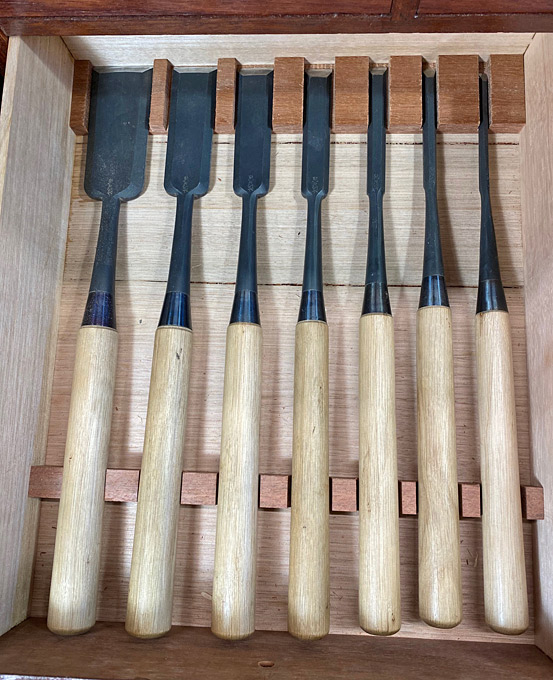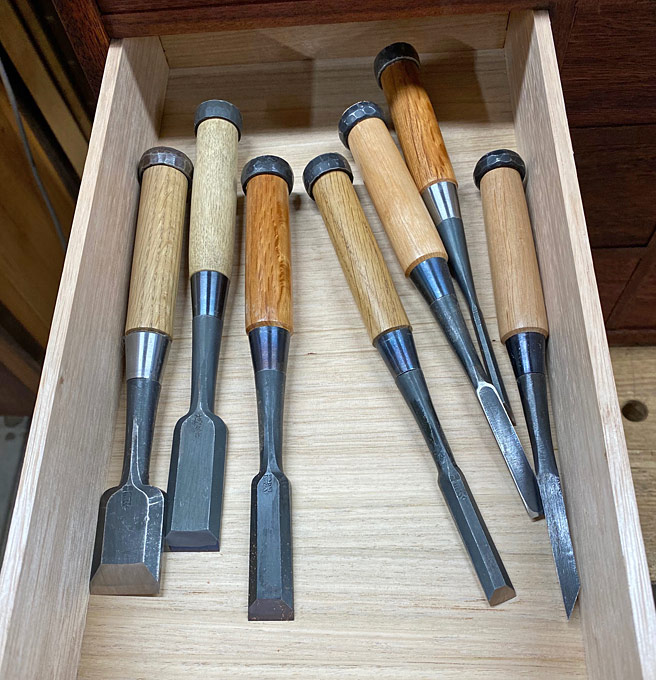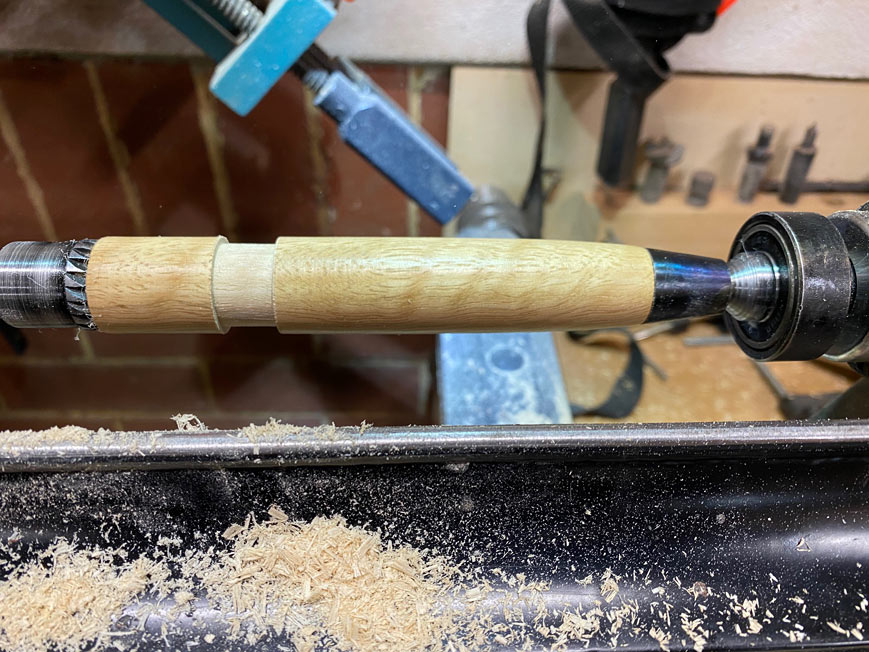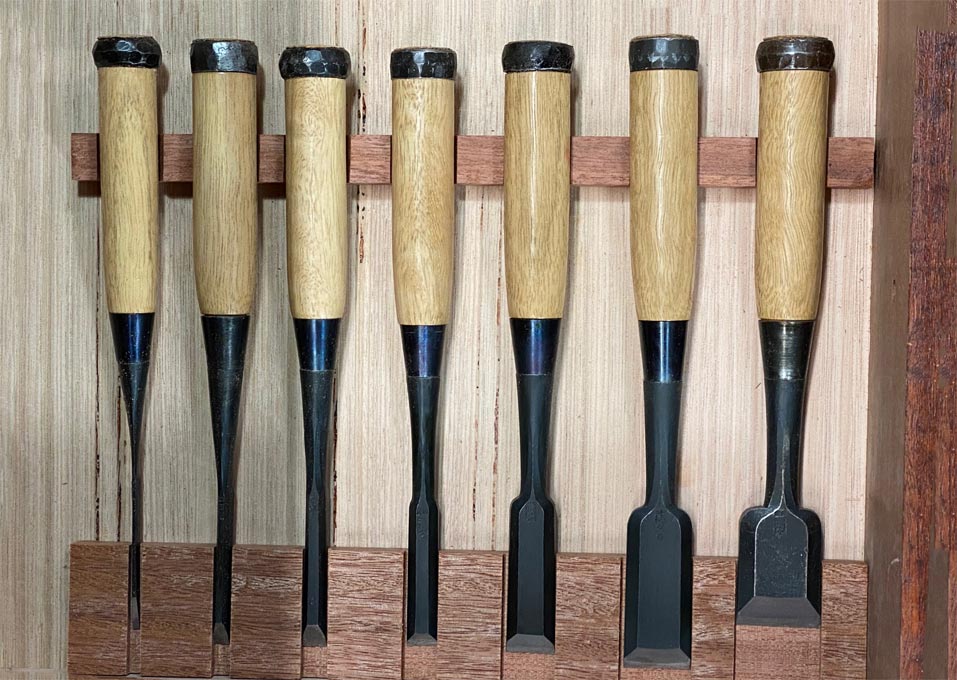derekcohen
Member
- Joined
- Jun 22, 2008
- Messages
- 1,003
About 10 years or so ago, I was fortunate enough to purchase a set of Kiyohisa slicks from the maker, Watanabe Kiyoe, through So Yamashita (Japan-Tool.com). These have been incredible chisels and a joy to use when building furniture. As much art as tool.
Part of the motivation for this thread comes from the completion of the underbench cabinet. Here are the Kiyohisa slicks in a drawer (beginnings of fitting tools into the drawers) ...

Of course, over the years, I wished I have been able to order a set of Kiyohisa oire nomi (bench chisels). Not only were these very expensive several years ago, plus there was a wait list of several years, but Watanabe is no longer making chisels owing to ill health. The price of his tools has rocketed.
Over time I have managed to put together a collection of Kiyohisa oire nomi purchased individually. Hence the range of handles, below ...

Handles and wood for handles
My plan was to change the handles - creating a unified appearance - but first I needed to find a suitable wood. The woods for Japanese oire nomi was discussed recently. Japanese White- or Red Oak is not available in Australia, and I really did not wish to use something that looked different. There are a number of Australian hardwoods that are suitable for chisel handles generally, but not in keeping with the look I wished to preserve. One choice I had was Beech (courtesy of an old jack plane).

(My iPhone camera seems to skew the hoops)
This is a nice look with excellent mechanical properties, and a gentle colour and grain. However, it did not quite lend itself to the colour and figure I was seeking to reproduce. I had already tried US White Oak, but found it too coarse grained.
In the end I plumped for Tasmanian Blue Gum, also known as Southern Blue Gum …
The colour of southern blue gum timber ranges from pale straw to brown, often with blue, green or grey tinges. Regrowth material can exhibit shades of pink. Sapwood is somewhat paler than the heartwood, but not always clearly demarcated. Growth rings are prominent on end sections. Grain is often interlocked with a medium and relatively even texture.
https://www.woodsolutions.com.au/wood-species/gum-southern-blue
With careful selection, it was possible to find sections with straightish grain and just a little – almost unnoticeable - grey-blue tinge here-and-there. I think that it did a good job of resembling Japanese White Oak in colour …
First Modification
The other factor was that I wanted to make the handles a little thicker, which would better fit my larger-than-average size hand. The typical oire nomi is 20mm across. I planned to make these 22-23mm across.
Second Modification
The wider handles led to a second modification, which involves setting the hoops differently. The ends of the handle were rebated on the lathe …

As a result of this, the hoops sit flatter on the handle. The two on the left are modified, and the two on the right are standard …

I like this effect. The handles are more comfortable to hold.
Each chisel was friction-sealed in buffing oil on the lathe, and then finished in Ubeaut Hard White Shellac.
So, seven chisels in all. Seven new handles. Here is the completed set (30mm down to 3mm) …

Nothing fitted yet. Just planning ...

Regards from Perth
Derek
Rebuilding a Kiyohisa Oire Nomi: http://www.inthewoodshop.com/ToolRestorations/KiyohisaRebuild2.html
Part of the motivation for this thread comes from the completion of the underbench cabinet. Here are the Kiyohisa slicks in a drawer (beginnings of fitting tools into the drawers) ...

Of course, over the years, I wished I have been able to order a set of Kiyohisa oire nomi (bench chisels). Not only were these very expensive several years ago, plus there was a wait list of several years, but Watanabe is no longer making chisels owing to ill health. The price of his tools has rocketed.
Over time I have managed to put together a collection of Kiyohisa oire nomi purchased individually. Hence the range of handles, below ...

Handles and wood for handles
My plan was to change the handles - creating a unified appearance - but first I needed to find a suitable wood. The woods for Japanese oire nomi was discussed recently. Japanese White- or Red Oak is not available in Australia, and I really did not wish to use something that looked different. There are a number of Australian hardwoods that are suitable for chisel handles generally, but not in keeping with the look I wished to preserve. One choice I had was Beech (courtesy of an old jack plane).

(My iPhone camera seems to skew the hoops)
This is a nice look with excellent mechanical properties, and a gentle colour and grain. However, it did not quite lend itself to the colour and figure I was seeking to reproduce. I had already tried US White Oak, but found it too coarse grained.
In the end I plumped for Tasmanian Blue Gum, also known as Southern Blue Gum …
The colour of southern blue gum timber ranges from pale straw to brown, often with blue, green or grey tinges. Regrowth material can exhibit shades of pink. Sapwood is somewhat paler than the heartwood, but not always clearly demarcated. Growth rings are prominent on end sections. Grain is often interlocked with a medium and relatively even texture.
https://www.woodsolutions.com.au/wood-species/gum-southern-blue
With careful selection, it was possible to find sections with straightish grain and just a little – almost unnoticeable - grey-blue tinge here-and-there. I think that it did a good job of resembling Japanese White Oak in colour …
First Modification
The other factor was that I wanted to make the handles a little thicker, which would better fit my larger-than-average size hand. The typical oire nomi is 20mm across. I planned to make these 22-23mm across.
Second Modification
The wider handles led to a second modification, which involves setting the hoops differently. The ends of the handle were rebated on the lathe …

As a result of this, the hoops sit flatter on the handle. The two on the left are modified, and the two on the right are standard …

I like this effect. The handles are more comfortable to hold.
Each chisel was friction-sealed in buffing oil on the lathe, and then finished in Ubeaut Hard White Shellac.
So, seven chisels in all. Seven new handles. Here is the completed set (30mm down to 3mm) …

Nothing fitted yet. Just planning ...

Regards from Perth
Derek
Rebuilding a Kiyohisa Oire Nomi: http://www.inthewoodshop.com/ToolRestorations/KiyohisaRebuild2.html

